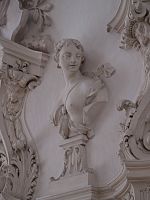Charles Claude Dubut
Charles Claude Dubut (* around 1687 in Paris ; † May 23, 1742 in Munich ) was a French sculptor and plasterer .
Life
After his training in Paris and Rome , Charles Dubut worked at the Dresden court, then in Berlin . During the Eosander era he worked for the Prussian King Friedrich I with J. Esclafer. He created impressive stucco work for the Berlin City Palace - for example in the large picture gallery.
In 1716 Bartholomäus Damart became a court sculptor in Berlin, while Dubut was appointed to the Bavarian court by the Bavarian Elector Maximilian II Emanuel ("expressé to come to Munich") and received 600 guilders as "an extremely famous sculptor".
In Munich he had been running a sculptor's workshop and bronze foundry in the Neudeck Castle Garden in the Au since 1718 . His colleagues in Munich were Nicolas Le Tellier (1724/1725), Christian Dargoust (Argoust), Johann Esclafer, Dominicus, Maratti, Magnus Veichtmayer and, from 1732, two of his sons: Jean Dubut was a painter (mentioned 1756/1766) and Friedrich Wilhelm Dubut (* 1711) was a sculptor, after 1742 a wax boss with August III. from Poland .
After Maximilian Emanuel's death, Dubut fell victim to the austerity measures taken by his successor: from 1727 he received no more payments and the court owed him 9,000 guilders. He lived in dire poverty with his nine children.
plant
Charles Dubut created works in the style of late Louis XIV under the Bavarian court architect Joseph Effner and was involved in the interior design and facade decoration for the Schleißheim , Fürstenried and Nymphenburg palaces , for the Munich Residence and the Badenburg in the Nymphenburg Palace Park . He created architectural sculptures in stucco , cast iron and bronze such as coats of arms, mascarons (for example at the entrance to the Nymphenburg Palace), groups of putti, reliefs, decorative vases, trophy bundles, herms, sphinxes , picture frames, flower baskets and bronze basins. 1719 a model for the staircase of Schleissheim Palace "on Mr. Effner's acquisition", the "23 chapters and two model and form of plaster of the two main characters on the main staircase to Schleissheim". The 12 Hercules Hermen with putti reliefs in the Schleißheim Viktoriensaal, one of the most beautiful interiors of the Baroque era, are significant. A wax bust of Elector Maximilian Emanuel is in the Bavarian National Museum in Munich.
literature
- Max Hauttmann: Dubut, Charles-Claude . In: Ulrich Thieme (Hrsg.): General Lexicon of Fine Artists from Antiquity to the Present . Founded by Ulrich Thieme and Felix Becker . tape 10 : Dubolon – Erlwein . EA Seemann, Leipzig 1914, p. 18 ( Textarchiv - Internet Archive ).
- Charles Claude Dubut . In: General Artist Lexicon . The visual artists of all times and peoples (AKL). Volume 30, Saur, Munich a. a. 2001, ISBN 3-598-22770-1 , p. 132.
- Heinz Ladendorf: The sculptor and builder Andreas Schlueter . Berlin 1935.
- Max Hauttmann: The Bavarian court architect Joseph Effner . Strasbourg 1913.
- Official guide of the Bavarian administration of the state palaces, gardens and lakes to the palaces Nymphenburg and Schleissheim as well as the Munich residence . Munich 2008.
in particular: - Ernst Götz, Brigitte Langer: Schleißheim palace complex. Official leader . New version. Bavarian Administration of State Palaces, Gardens and Lakes, Munich 2005, ISBN 3-932982-55-X .
Web links
- Charles Claude Dubut on answers.com
| personal data | |
|---|---|
| SURNAME | Dubut, Charles Claude |
| ALTERNATIVE NAMES | Dubut, Charles-Claude |
| BRIEF DESCRIPTION | French sculptor and plasterer |
| DATE OF BIRTH | around 1687 |
| PLACE OF BIRTH | Paris |
| DATE OF DEATH | May 23, 1742 |
| Place of death | Munich |





